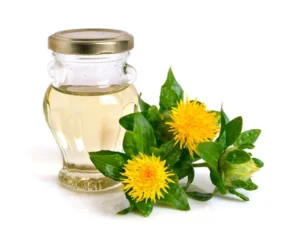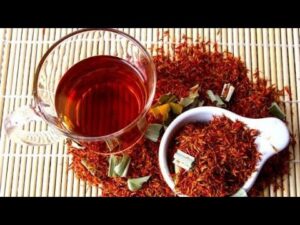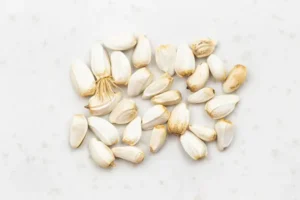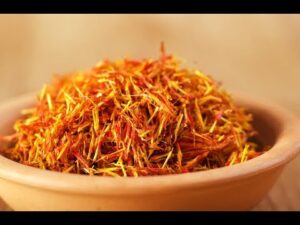The safflower plant, scientifically known as Carthamus tinctorius and part of the Asteraceae family, is renowned for its vibrant orange and red flowers. The Safflower Plant Uses are diverse, ranging from culinary and industrial applications to ornamental purposes. Additionally, the safflower plant offers numerous health benefits. Whether it aids in weight management, soothes inflammation, or helps control diabetes, the uses of the safflower plant are extensive and continually enrich our lives. In this article, we will explore in detail the magic of the safflower plant, examining its uses, benefits, and potential side effects.
Safflower Plant Uses
Safflower is a versatile plant, with a wide array of benefits and uses in various fields.
In the following lines, we will divide its uses into 3 categories: Culinary uses, Medicinal uses, and Other applicable uses, so let’s dive into safflower rich world.
A. Safflower Culinary Uses
Safflower plant uses in the kitchen are many, and its different parts can be used in unique ways in your kitchen. In this part, we will discover safflower oil, seeds, petals, and flowers, each with a variety of culinary uses and delight to deliver.
1. Safflower Oil Culinary Uses

Safflower oil is extracted from the seeds of the safflower plant, providing a healthy unsaturated substitution with many health benefits, unlike many other saturated oils.
Sautéing and Stir-Frying
Heat a splash of safflower oil in the pan and then add the veggies, proteins, or grains for the flavorful and nourishing stir-fry. The mild flavor of safflower oil blends with ingredients and creates a harmony where their flavors and textures are fully expressed.
Salad Dressings
Another one of the culinary safflower plant uses is to come up with unforgettable special dressings where safflower oil will be the key star ingredient. Combine balsamic vinegar, a splash of citrus juice, herbs, and spices with safflower oil for a zesty dressing that perfectly complements your favorite salads.
2. Safflower Petals Culinary Uses

Though safflower petals are mostly used for their bright colors in natural dyeing, they also provide a floral taste which can enhance the flavor of your culinary creations.
Infused Vinegar
Complete your pantry with safflower-infused vinegar and invite sophistication into your kitchen. This is super easy to prepare. Just put some safflower petals in a clean, sterilized jar, with white wine vinegar, and steep for a few days. Strain the petals out and enjoy the exquisite flavors in your salads, sauces, and marinades.
Herbal Tea Blends
Make a herbal tea blend that smells and tastes well by mixing safflower petals with other culinary herbs like chamomile, lavender, or mint. Steep the blend in hot water for a few minutes, then strain and delight yourself with delicate floral notes of safflower in every sip, and the extract of benefits of safflower plant.
3. Safflower Seeds Culinary Uses

Though safflower seeds are best known for their oil content, they still have the wonderful characteristic of bringing on a nutty crunch that can bring more texture and flavor to different dishes.
Read Also:Best Method to Dry Parsley
Salads
You can use safflower seeds juice to add to salad dishes, elevating their taste and exploiting various benefits of safflower plant in each spoon.
You can also sprinkle toasted safflower seeds over salads for a crunchy and nutritious topping. Simply toast safflower seeds in a dry skillet until golden brown and fragrant, then let cool before adding to salads for a burst of flavor and texture.
4. Safflower Leaves Culinary Uses

While safflower leaves are often overlooked, they offer a delicate flavor and tender texture that can enhance a variety of dishes.
Classic Indian Dish
Safflower leaves are the main component in an Indian cuisine recipe called “ Kusum Bahji”, where safflower leaves are boiled for 5 minutes, then combined with other ingredients like garlic, cumin, tomatoes, turmeric powder, and red chili powder, resulting in a delicious dish accompanied with many health benefits of safflower plant.
B. Safflower Medicinal Uses
Apart from culinary safflower plant uses, safflower has a tremendous therapeutic value, offering an array of health benefits that have been recognized by ancient healers and modern researchers alike. On the other hand, the medicinal benefits of safflower plant seem to be old but recently carried-out studies show that it has some of the properties related to its traditional uses; for instance, reducing blood pressure and improving heart health, blood flow, and blood sugar control.
Some notable health benefits of safflower plant include:
1. Heart Health
Safflower oil contains linoleic acid (n-6 polyunsaturated fatty acid) and oleic acid (monounsaturated fatty acid), and both these fatty acids are known to lower levels of LDL cholesterol (Bad Cholesterol), hence improving blood lipid profiles, and promote cardiovascular health. Consuming safflower oil moderately (without an excessive manner of consumption) may decrease the risk factors for heart disease.
Additionally, safflower oil exhibits anti-inflammatory properties where it may help to reduce the inflammation inside the cardiovascular system, and so protecting against arterial plaque buildup and atherosclerosis.
2. Weight Management
Weight management is another tremendous benefit of safflower plant uses, as studies stated that safflower oil might assist in weight loss and reduce the accumulation of fats by boosting fat burning and the sensation of fullness. By incorporating safflower oil into a balanced diet and an active lifestyle, its metabolic-boosting characteristics can be exploited for weight management purposes.
3. Skin Nourishment
Safflower plays a vital role in promoting radiant skin health, offering a holistic approach to beauty and wellness. Safflower oil serves as a luxurious moisturizer, penetrating deep into the skin to hydrate, nourish, and rejuvenate from within.
Full of linoleic acid and vitamin E, safflower oil maintains the skin’s barrier function by preventing moisture loss and also protects it from the impact of UV radiation and pollution.
Additionally, Linoleic acid exhibits anti-inflammatory properties that can help calm and soothe irritated or inflamed skin, offering possible safflower plant uses in cosmetics products, which can be beneficial for individuals with conditions such as eczema and acne.
4. Anti-inflammatory Effects
Safflower has been proven to have strong anti-inflammatory properties that make it possible to alleviate pain, swelling, and discomfort associated with inflammations of muscles and joints like arthritis.
Safflower is rich in bioactive compounds such as flavonoids and polyphenols, which work in synergy to regulate inflammatory pathways within the body. The anti-inflammatory compounds in safflower help reduce heart diseases by reducing inflammation and oxidative stress.
Whether applied topically as a soothing oil or taken as a dietary supplement, anti-inflammatory safflower plant uses are a natural way to help relieve inflammation and reestablish overall well-being.
5. Easing Menstrual Complications
With its anti-inflammatory and analgesic properties, safflower plant uses can extend to ease pelvic pains and muscle cramps, thus offering comfort and relief to those who have menstruation. Moreover, the benefits of safflower plant extend to helping to balance hormonal levels and make the premenstrual syndrome (PMS) symptoms more bearable and enabling women to go through the menstruation cycle with less pain and hardship,
6. Managing Diabetes
Safflower oil containing high levels of polyunsaturated fatty acids like linoleic acid has expressed efficacy in managing diabetes. Research suggests that safflower oil consumption on a regular basis can help to enhance insulin sensitivity and lower blood sugar levels in people with type 2 diabetes. Its anti-inflammatory properties and ability to regulate the metabolism of lipids may extend the benefits of safflower plant to be an important reason for diabetes control.
Integrating safflower oil into a balanced diet in combination with other healthy habits such as physical activity may be a natural way of blood sugar management in people suffering from diabetes.
C. Other Safflower Plant Uses
1. Natural Dyeing
Traditionally, safflower petals were used for preparing natural dyes, thus producing vibrant shades of yellow, orange, and red. One of the possible safflower plant uses natural dye is using it as a substitute for synthetic colorants in textile and cosmetic industries.
2. Biodiesel Production
Safflower oil seems to be a renewable source of biodiesel that is the most eco-friendly substitute for fossil fuels. Oil-rich seeds of safflower can be processed into biodiesel which leads to one of possible safflower plant uses as a renewable source of energy as well as reduction of greenhouse gas emissions and mitigating of climate change.
3. Garden Delight
Safflower adds ornamental value to a garden with a low-maintenance nature, making it a perfect choice for your garden. Through its deep taproot system, it has the ability to survive in arid conditions and plays a very major role in promoting sustainable agriculture in drought-prone areas. Safflower flowers offer a rich source of nectar and pollen to bees and other pollinating insects, so safflower plant uses extend to contribute to biodiversity and ecosystem health.
Safflower Oil Side Effects
- High Omega-6 Content
Safflower oil is one of the richest sources of omega-6 fatty acids and mainly linoleic acid which is a polyunsaturated fatty acid. Whilst omega-6 fatty acids are important for the body’s well-being, their excessive consumption may result in disrupting the balance between omega-6 to omega-3 fatty acids in the diet, which in turn may be related to inflammation or other health issues.
- Potential Oxidative Damage
Like other vegetable oils, safflower oil is vulnerable to oxidation when subjected to heat and light. Oxidation results in the formation of free radicals that can affect cellular damage and thus incur conditions like cardiovascular disease and cancer.
Make sure to check the oxidative stability of your safflower oil product, which is its oxidation resistance, and keep caution of continuous high temperature, and store it in cool temperature. All of these will contribute to making the best out of the benefits of safflower plant.
- Risk of Allergic Reactions
Those who experience allergies to plants that belong to the Asteraceae family, which include ragweed, marigolds, and daisies, may have allergic reactions to safflower oil. Symptoms such as irritation of the skin, problems breathing, and distress in digestion could also occur.
Read More about: How Much Saffron to Use
Conclusion
Safflower plant uses are very versatile, from health issues to industrial and environmental applications. As well as additives in cosmetics, food preparation, and dyeing, all these benefits just showcase the benefits of safflower plant. Being very versatile in the kitchen one can easily use safflower oil for various purposes, but some people may have problems with such high levels of omega-6 acids and its oxidation instability, so we should take it within the balanced main diet and healthy lifestyle not to miss any of benefits of safflower oil.
FAQs
- What can I do with safflower plants?
Safflower plants offer versatile uses. You can harvest their oil-rich seeds for culinary purposes, utilize safflower oil in cooking or skin care, brew safflower tea for potential health benefits, and utilize safflower petals for natural dye production.
- Can you eat safflower?
Yes, safflower seeds and oil are edible. Safflower petals can also be used to make tea. However, moderation is key, and some people may have allergies or sensitivities.
- What are safflower leaves used for?
Safflower leaves are primarily used for medicinal purposes, offering potential benefits such as treating fevers, promoting digestive health, and addressing respiratory issues in traditional herbal medicine practices.
- What is safflower flower good for?
Safflower flowers are primarily valued for their ornamental beauty and as a source of natural dye. Additionally, they may have potential medicinal applications in traditional herbal remedies.



















